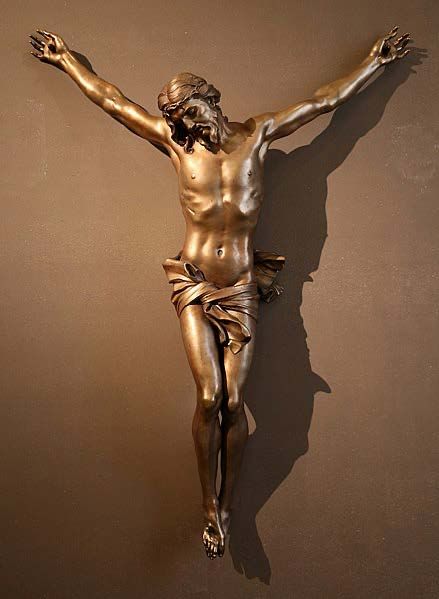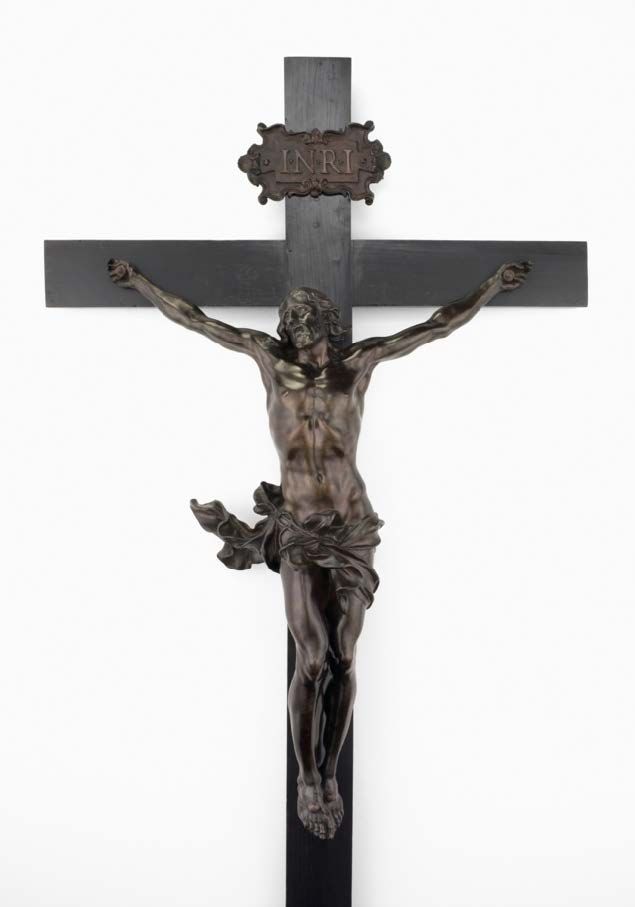Art
But is it a Bernini? A Tale of Contested Identity in the Art World
How the bronze crucifix in the Art Gallery of Ontario got from seventeenth-century Rome to twenty-first century Toronto is an intriguing tale, but it is a narrative filled with gaps.

The permanent collection of the Art Gallery of Ontario (AGO) in Toronto contains a bronze sculpture entitled The Crucified Christ (Corpus) and attributed to the seventeenth-century Roman artist Gian Lorenzo Bernini. The piece was donated to the art gallery by the late Murray Frum in 2006. What isn't well known is that the bronze was lost to history for centuries, and even after decades on the art market, the campaign to attribute the work to Bernini only began about twenty years ago. Visitors to the Toronto gallery are given no reason to think that the attribution is controversial. But there is good evidence to suspect that the $50 million bronze is not what it is claimed to be.

I stumbled upon this controversy during a recent exchange with Professor Franco Mormando—a world-class Bernini scholar and the author of the 2011 biography Bernini: His Life and His Rome. In a discussion about Bernini’s politics, Mormando let slip that “there is a great debate among Bernini scholars about the attribution of the AGO bronze crucifix.” I was shocked to hear this at first. I had casually followed the story of the Frum donation in the local newspapers, and I visit the AGO several times a year, but I had never caught even a whiff of the controversy. I imagine most of the public are unaware of this.
How the bronze crucifix in the Art Gallery of Ontario got from seventeenth-century Rome to twenty-first century Toronto is an intriguing tale, but it is a narrative filled with gaps. Fortunately, there is a lot that we do know. Bernini was first commissioned to produce a bronze crucifix for the king of Spain in 1653–54. That work, still extant, looks very much like the AGO bronze, especially to the untrained eye.

A year or so later, a second crucifix was commissioned by Cardinal Francesco Barberini for his Parisian residence and donated to King Louis XIV after the Cardinal’s death. It is recorded in the 1684 royal inventory but seems to have gone missing just before the French Revolution. Was it melted down in an anti-clerical frenzy, or did it manage to survive the Terror, having been smuggled away to somewhere safe? We don’t know. In addition, yet another bronze is mentioned in the historical record. According to an early biographer, this was a sculpture that Bernini initially “made for himself” and which the sculptor then gave to Cardinal Francesco Maria Sforza Pallavicino when Bernini visited Paris in 1665. Unfortunately, the historical trail goes cold here, until the early twentieth century.
In 1908, in Venice, a Parisian art dealer sold a large, bronze crucifix to an American financier. At this point, there was no suggestion that the work could be a Bernini. A few decades later, the bronze was sold to Geraldine Rockefeller Dodge, in whose private collection it remained until 1975, when it was part of an estate sale at Sotheby’s. At the auction, the bronze, which was described as “French late 17th century,” failed to fetch its meagre $200 asking price. Eventually, the work was purchased by an antique dealer in London, after which it bounced between private collectors in Spain and Monte Carlo.
This is when the attributions to Bernini began. In 2002, the Italian art critic Maurizio Fagiolo dell’Arco declared that the bronze was, in fact, the sculpture that had passed from Cardinal Barberini to Louis XIV centuries earlier. Then, in 2005, another highly regarded Italian art historian, Tomaso Montanari, argued that the bronze was in fact the other missing sculpture—the one Bernini gifted to Cardinal Pallavicino back in 1665. Art historian and dealer Andrew Butterfield also endorsed the Bernini attribution on behalf of the (now defunct) Salander–O’Reilly gallery in New York, run by disgraced gallerist Larry Salander. In a breathless 2016 profile of Butterfield for the Financial Times, Dalya Alberge claims that the art dealer “was able to prove … that a bronze statue of the crucifixion that had failed to sell at auction in 1975 for $200 was in fact a lost Bernini now worth a staggering $50 million.” The major American art museums did not seem to share this conviction. None of them agreed to purchase the supposed Bernini.
Enter Murray Frum. Frum was a public-spirited Toronto businessman and art collector who, to his credit, believed that the apparently long-lost Bernini should be enjoyed by everyone. Frum purchased the bronze for $25 million and donated it to the AGO. Its appraised value quickly swelled to double the purchasing price.
As noted, there are critics who are sceptical that the piece is a genuine Bernini. Art historian and specialist in the Baroque period Charles Scribner III is among those who have challenged the claim. Scribner does not contend that the AGO bronze is a forgery or fake. Instead, he believes that the sculpture is a pastiche: the result of a “joint project” by Bernini himself and other sculptors (“non-Bernini,” as he puts it). According to Scribner, it is neither the bronze commissioned by Cardinal Barberini (as Fagiolo dell’Arco claimed) nor the one that Bernini supposedly “made for himself,” before gifting it to Cardinal Pallavicino (as Montanari believes). Scribner thinks that some parts of the AGO bronze were probably made from Bernini’s original moulds, but other parts were cast from moulds made by other people. There are compelling reasons to believe that Bernini himself was not involved in the completion of the work.
So, what is so “non-Bernini” about the AGO bronze? For Scribner, the most compelling piece of evidence is the lack of a “side wound.” The gospels relate that, when Christ died, a Roman centurion (a man named Longinus according to later, extra-Biblical texts) “pierced his side, and forthwith came there out blood [invoking the Eucharist] and water [Baptism].” Tradition has it that, as a result of witnessing this miraculous event, Longinus converted from paganism to Christianity. The side wound is clearly present on the Spanish bronze—and on every single sculpture of the dead Christ that we can confidently attribute to Bernini. Dozens of these smaller works populate the Vatican. The first reason to be sceptical, then, is this evident inconsistency.

Of course, oversights happen. Perhaps Bernini was on a tight deadline and, in his hurry, omitted a detail that would have been added late in the “construction” process—at the stage of final chasing. But if the AGO bronze was originally designed for Bernini himself, for his own private devotions (and he was devout), then the omission seems inexplicable. If Montanari is correct, this was not a commissioned work that Bernini was desperate to get out the door quickly. It seems odd that Bernini would have omitted this theologically crucial detail—especially since, in 1638, he had spent months in the Vatican carving a massive sculpture of the centurion in question.

Bernini had spent significant time and energy, then, toiling away at a sculpture of Longinus—a work whose creation would have required both physical exertion and intellectual focus—trying to depict the complex psychology of his subject and the religious significance of his actions. It is hard to imagine that he would have deliberately omitted include the side wound in a subsequent work made purely for himself.
For Scribner, the second problem is the drapery. If we look carefully, we can see that the drapery of the earlier, Spanish bronze is flatter and more compact and lacks what the AGO curators describe as “the dynamic movement of the loincloth.” This constraint is appropriate, given that this is a depiction of the dead Christ. It invites the viewer to focus on the lifeless body on the cross. By contrast, the drapery on the AGO bronze looks as if it has been captured mid-movement. It seems to be almost whooshing upwards—a dynamism more appropriate for depictions of a still-living Christ. Montanari explains this inconsistency by speculating that the AGO bronze is neither a true Cristo morto nor a Cristo vivo, but depicts a comatose Jesus, caught in the moment between life and death. The loincloth’s upward flourish thus prefigures Christ’s ascension to heaven. But it seems unlikely that Bernini—artist and impresario of the Counter-Reformation—would have taken such liberties with representational tradition or theological orthodoxy. It seems much more likely that the drapery was cast by someone other than Bernini and without his oversight.

In fact, as Scribner argues, the levitating drapery on the AGO bronze is more stylistically akin to the drapery cast by Bernini’s Roman rival, Alessandro Algardi. If we accept Montanari’s thesis that the AGO bronze was a work Bernini made for his own personal use, why would he have copied the signature flourish that characterised Algardi’s depiction of Christ’s loincloth?

Of course, this similarity does not definitively prove the sceptics’ case, but art attribution is often a matter of interpreting subtle clues and patiently accumulating evidence.
When we look at the two bronzes side by side, we can spot other differences, too. While the heads and upper bodies are very similar (and possibly cast from the same mould), the legs and feet are clearly not the same. The AGO’s Christ has thinner, almost sinewy legs, and his feet are longer. His lean lower body contrasts strikingly with his muscular arms and torso—a tension that is absent from the Spanish bronze. As a result, AGO’s Christ is not as harmonious a composition as the earlier work, upon which it was modelled.
When the two bronzes were displayed side by side at a Bernini exhibition at Rome’s Borghese Gallery in 2017–18, Bernini scholar Anna Coliva, former director of the Borghese, found their discrepancies striking:
The placement of the marvellous gilded bronze crucifix from the Escorial [the Spanish bronze] executed by Bernini between 1654 and 56, next to the bronze crucifix acquired by the Toronto Museum in 2006, revealed that a direct execution by Bernini [of the latter] was untenable ... The details, observable so close together, revealed the relative lack of skill in the casting technique of the Toronto version compared to the very high level of the one in the Escorial; just as the compactness of the proportions of the latter reveals the incongruous attenuation of the limbs which give the Canadian crucifix a “slithery” shape. [All translations from the Italian are by Charles Scribner III.]
In his 1955 book Bernini: The Sculptor of the Roman Baroque, Rudolf Wittkower includes a comprehensive list of all the works then known to be by Bernini. Obviously, this “catalogue raisonnée”—which was considered the authoritative source of Bernini attributions for generations—did not include the AGO bronze, which, as noted above, was still being described as a “late French 17th century” work at auction twenty years later. Recently, however, Maria Grazia Bernardini has published a massive, updated catalogue that meticulously documents both Bernini’s certified works and those with contested attributions. In her entry on the AGO bronze she writes:
In juxtaposition, the two [the Escorial bronze and the AGO bronze] appear similar yet with profound differences: they derive from the same prototype but with substantial differences in details that render Montanari’s hypothesis untenable that the AGO version came from the model, even if revisited, for the Escorial [Spanish] corpus … the legs are longer and thinner … the prominent abdomen is completely altered in its connection with the upper torso … Pending further findings by critics, the Toronto bronze must therefore be assigned to an artist in the circle of Bernini, based on a prototype by Bernini, but without his intervention.
Some art historians do support the attribution to Bernini, however. Evonne Levy, a world-class Bernini scholar from the University of Toronto, agreed with the AGO's attribution. But some scholars clearly remain sceptical. Given the lack of scholarly consensus, why is a Toronto art museum claiming to possess a Bernini? Perhaps because of the incentive structures that operate throughout the art world. Rescuing a long-lost work from obscurity and restoring it to its rightful place in the canon is surely the dream of many art historians. Commercial galleries and auction houses are likewise motivated to upgrade works, as owning and displaying famous works brings them money and prestige. Wealthy donors and philanthropists want to purchase and donate big-name works in order to increase their social capital and burnish their legacies. Prestigious museums and galleries aggressively pursue works by canonical figures, as they attract visitors and enhance their institutional reputations. Local academics, who need to work closely with those museums and galleries, also have a vested interest in flattering museum directors by ignoring potential attribution controversies. Government agencies are more likely to dole out grants to people working on projects featuring well-known artists. And the thousands of visitors who pour through the doors of galleries like the AGO are clamouring to see works fashioned by those luminaries whose names they remember from their art history survey courses and their high school textbooks.

So, how should the AGO handle this? I think they should let the public know about the controversy. The curators could mount a photograph of the Spanish bronze next to the supposed Bernini and invite viewers to spot the differences. They might include a brief summary of its attribution history in the label next to their sculpture. There’s a compelling story here, and AGO visitors are surely mature enough to understand that it is not always possible to be certain about the provenance and authorship of a centuries-old artwork. We could all learn something important from this—but only if the museum curators and gallery directors are willing to engage with the sceptics.






